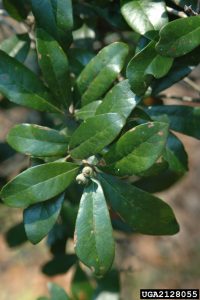
Do you have more acorns than you know what to do with? When oaks produce loads of acorns, it sometimes is called a “mast” year. Do you remember the oak tree pollen and all those catkins that fell from oaks earlier in spring?
Catkins are the male flowers in oaks. Some people refer to them as tassels or worms. The airborne pollen from these catkins were part of the reproductive process in fertilizing the female oak flowers that ultimately resulted in all of these acorns. Oaks produce separate male and female flowers on the same tree. Female flowers in oaks are very small. You’d have to look very close to see them. Many oaks did well in their reproductive efforts this spring. Acorns are oak seeds. This entire process is part of the cycle of life.
There are theories about mast years, wildlife’s use of these acorns and what gardeners can expect next year as a result of this year’s abundant acorn crop. Timing of mast years is still a mystery. Numerous theories exist ranging from weather to geography to the life cycles of predators.
The most likely reason for high production seems to be weather-related. When oak trees have favorable weather at the time of oak flowering and good growing conditions, the mast seems to be increased.
But mast years happen irregularly, making it difficult to understand what causes a mast year. Heavy acorn production can occur twice in a row or it might be separated by several years or more. There’s no good way to predict it.
Mast years are important to wildlife, as acorns are an important food for many animal species. In low crop years, birthrate for some wildlife species, such as squirrels, will decline the following year. This also may involve increased competition for food and survival rates. The recent crop means that more young are likely to be produced by animals that forage for acorns.
Wildlife play a big role in forest regeneration. When acorns drop out of oaks, many animals help distribute these seeds. Squirrels can bury hundreds of acorns. Some of these acorns germinate and grow to become the next generation of oak trees. Some will be eaten by birds, bears, deer, rodents, including squirrels, and other wildlife. Rodents are in turn eaten by carnivores and deer browsing shapes which kinds of plants become established and survive. All those acorns have far-reaching impact on wildlife and our forests.
So, try to keep this in mind as you are fussing with all those acorns in your lawn and landscape this season.
 0
0
